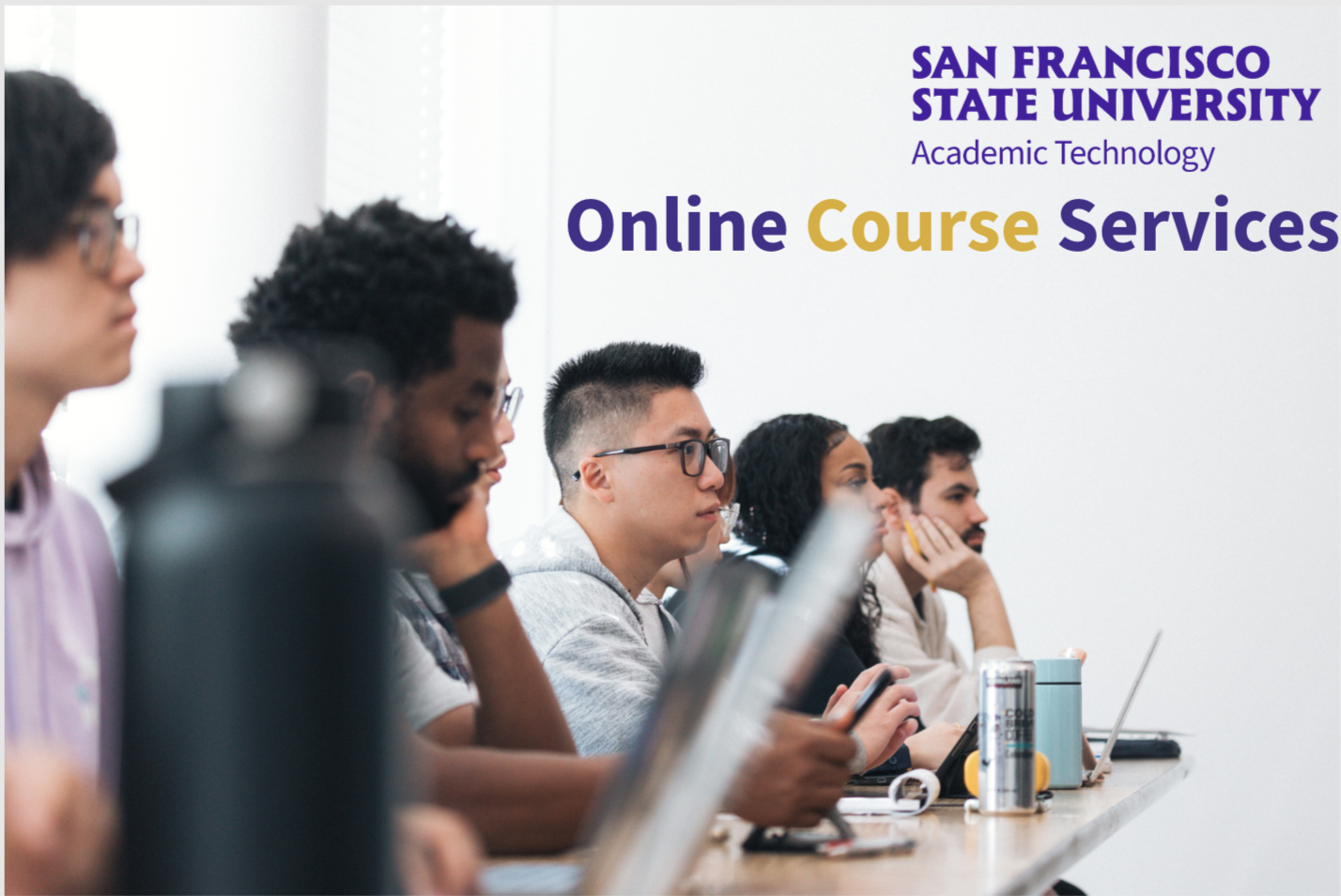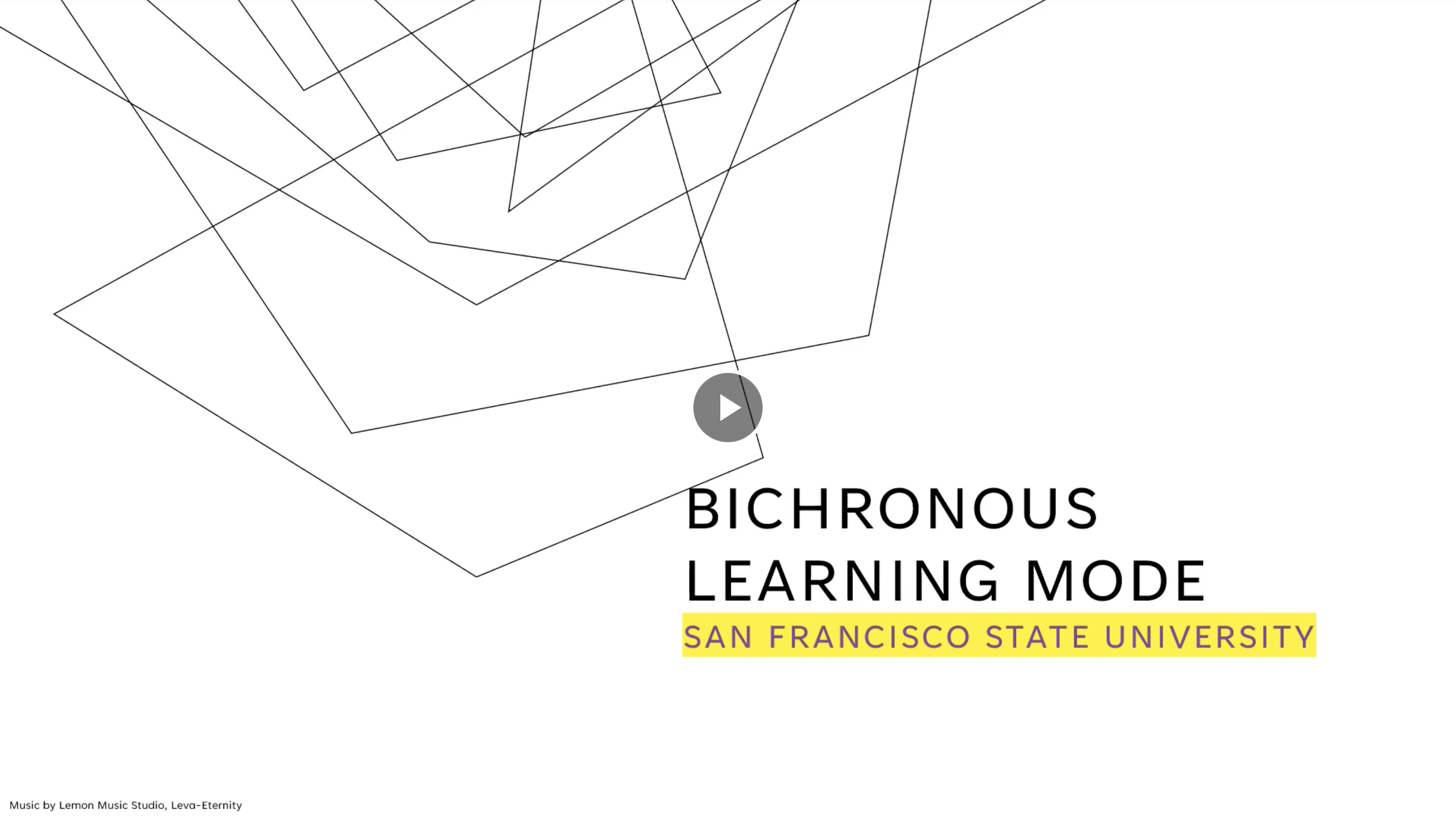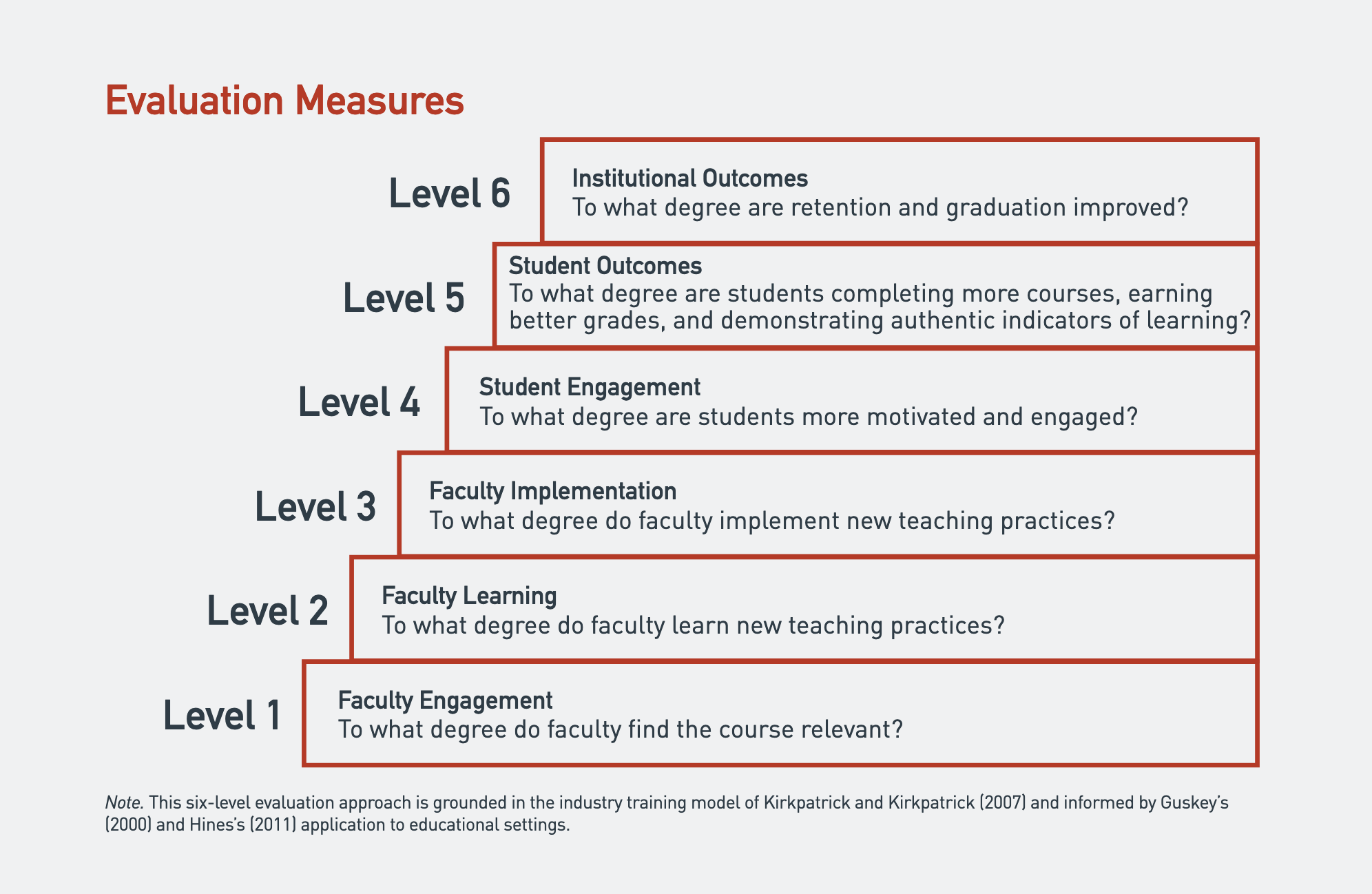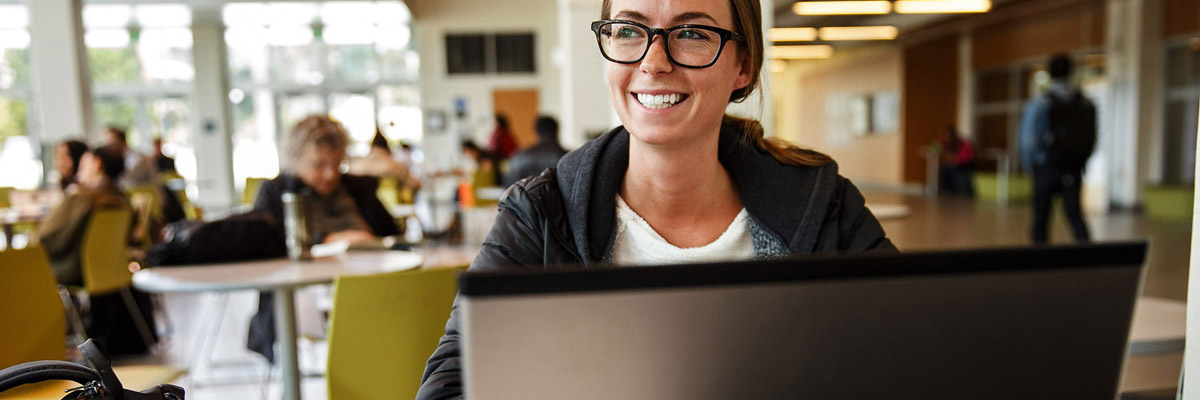
SF State’s Academic Technology unit support effective and quality online teaching through its Teaching and Learning with Technology team comprised of instructional designers and integrated with core learning technology support services across the unit. This includes consultation, multi-modal training engagements, and coordination of CSU and curated external learning opportunities. The team also collaborates with faculty to produce support materials and engagements and involves itself in campus governance to iteratively evolve its practice support campus needs.
Team:
- Andrew Roderick, Assistant Vice President, Academic Technology
- Angie Petty, Project Lead & Instructional Designer
- Breanna Hamm, Instructional Designer
- Brandon York, Instructional Designer
Campus Partners:
- The Center for Equity and Excellence in Teaching and Learning (CEETL)
- The Disability Programs and Resource Center (DPRC)
- Academic Technology Advisory Committee
2024-2025 Goal 1: Focus programming and faculty development offerings on support for emerging changes to course delivery, modality, and flexible needs as academic departments and faculty explore adjustments based on university downsizing related to enrollment decline. Our programming will stress key principles (meeting faculty where they are, embedding QM/QLT rubric elements, and maintaining quality amidst faculty course revision).
- Production of short-format, video-based professional development content has continued in the 2024-2025 covering a range of topics relevant to online teaching and effective use of technology. This work is branded as “One Little Thing” (https://at.sfsu.edu/one-little-thing) has published thirteen videos have been created between July 2024 and February 2025 including on using Canvas features effectively, AI-related training, and use of PollEverywhere for roster management.
This spring, we will be introducing faculty developed content on topics which include Enhancing Student Engagement, Confronting Technophobia, Using the Learning Glass Studio, and other tech topics. We expect those to be created between March and May 2025 and to be published incrementally across that period of time.
- Last year, Academic Technology partnered with the Center for Equity and Excellence in Teaching and Learning (CEETL) to develop and launch the Excellence in Online Pedagogies (EOP) course to support faculty and bring up-to-date previous faculty development curriculum. This year, we have relaunched the course with (1) a set of updates to better integrate and reinforce key QM/QLT rubric standards within the course and (2) introduce new micro-modules highlighting key pedagogical best practices. The revised course launched on February 17th including the new modules on Enhancing Student Engagement and Universal Design for Learning (UDL) which were added to increase the depth of content and tailor the course to current campus needs.
- The faculty fellow joined weekly team members, infusing the faculty perspective into discussions on Canvas roll-out issues, outreach, and strategic planning. Additionally, the faculty fellow gained insight into the complex management of a Learning Management System at scale.
2024-2025 Goal 2: Campus-wide AI Literacy Education Program
This is a multi-course offering of workshops aimed at broadly building campus AI readiness amongst all audiences (faculty, staff, administrators). The program offers to prerequisite courses on the basics and a growing series of electives on special topics (from image generation to using AI @ Work). Users who complete the two required courses plus one elective earn a digital badge. The workshops are offered synchronously with an accompanying Canvas course for ongoing reference and assessment. (https://ai.sfsu.edu/start-your-ai-journey).
2024-2025 - SQuAIR Research: Veracity of Learning Mode Codes
Dr. Jackson Wilson has launched a study on the veracity of the use and assignment of learning modes by faculty and departments. In particular, his study seeks to gather data from faculty regarding their assigned learning mode and the actual contact hours, learning options, in-person versus online contact hours, and other questions that will help show issues of alignment around selection of learning modes in comparison to actual instruction. The issues revealed can help point to remedies at SF State and at the systemwide level.
See the links below

SF State’s Academic Technology unit support effective and quality online teaching through its Teaching and Learning with Technology team comprised of instructional designers and integrated with core learning technology support services across the unit. This includes consultation, multi-modal training engagements, and coordination of CSU and curated external learning opportunities. The team also collaborates with faculty to produce support materials and engagements and involves itself in campus governance to iteratively evolve its practice support campus needs.
Team:
- Andrew Roderick, Assistant Vice President, Academic Technology
- Angie Petty, Project Lead & Instructional Designer
- Breanna Hamm, Instructional Designer
- Brandon York, Instructional Designer
Campus Partners:
- The Center for Equity and Excellence in Teaching and Learning (CEETL)
- The Disability Programs and Resource Center (DPRC)
- Academic Technology Advisory Committee
Section 1: SFSU OCS Accomplishments
2023-2024 OCS Goal 1:
Continue to offer programming to faculty as Canvas becomes the new campus Learning Management System.
2023-2024 OCS Goal 1 Accomplishments:
- Hired the first Canvas Faculty Fellow (English Department lecturer Esther Chan) who acted simultaneously as an internal consultant to the cross-disciplinary Canvas team, co-developed support materials for faculty, and participated in workshops and learning modules for faculty.
- The faculty fellow joined weekly team members, infusing the faculty perspective into discussions on Canvas roll-out issues, outreach, and strategic planning. Additionally, the faculty fellow gained insight into the complex management of a Learning Management System at scale.
- The faculty fellow co-developed workshops with Instructional Designers and attended (mostly) weekly online workshops to help and support to faculty in chat.
- The faculty fellow provided direct support to faculty, holding online office hours and taking on one-on-one support engagements scheduled through Academic Technology.
- The faculty fellow participated in strategic planning sessions that led to new programming (see “One Little Thing” below).
- Conceived and launched a new approach to faculty training and support with “One Little Thing”, a new short video series on Canvas and related topics focused on quick take-aways faculty can apply to their Canvas courses. The goal is to “meet faculty where they are” and as part of flagging longer length workshop attendance, provide quick, single-task oriented micro-resources that can improve course effectiveness.
- Developed and launched the “Renovate and Elevate Your Canvas Courses” asynchronous training course focused on supporting faculty who have recently migrated to Canvas utilize best practices for streamlining course content and improving usage of Canvas features.
- The course utilizes badging to help create a professional development incentive.
- The course was launched for Spring 2024 and has 35 faculty enrolled (with a significant outreach to faculty for summer 2024 professional development).
- https://at.sfsu.edu/news/renovate-and-elevate-your-canvas-course
- Developed and launched a full rebuild of the former Online Teaching Lab (OTL) course, now called “Excellence in Online Pedagogy (EOP)”. The module launched on April 1, 2024, for an initial 200 faculty who will receive stipends upon completion by May 6th, 2024.
2023-2024 OCS Goal 2:
SQuAIR research on CSU Fully Online with analysis on outgoing and incoming SF State student participation, course characteristics, and performance.
2023-2024 Goal 2 Accomplishments:
Dr. Jackson Wilson, the SF State SQuAIR representative has been responsible for completing this goal. Following submission of 2023-2024 report, a campus discussion led to the broadening of the research topic from a focus on bichronous learning to a broader examination of online course modalities that contribute to campus courses being listed on CSU Fully Online. The study examines student success factors in CSU Fully Online courses offered from SF State analyzing data from Fall 2021 through Spring 2023 to develop observations regarding incoming, outgoing, and general performance of SF State students using the program. It additionally examines course characteristics and distribution across subject areas.
A full draft of the report will be in final draft as of April 2024. The draft is currently under review and discussion by a group of campus stakeholders and Wilson is continuing to conduct research and data analysis. We expect a completed report and presentation by end of Spring 2024.
Section 2: SFSU OCS Project Plan
2023-2024 Goal 1:
Focus programming and faculty development offerings on support for emerging changes to course delivery, modality, and flexible needs as academic departments and faculty explore adjustments based on university downsizing related to enrollment decline. Our programming will stress key principles (meeting faculty where they are, embedding QM/QLT rubric elements, and maintaining quality amidst faculty course revision).
Activities included:
- Embedding Faculty Voice and Practice into new and existing professional development materials: Our unit have developed a wide range of support documents, modules, and video support segment but has lacked faculty peer-based voices and demonstration in the materials. To fill this gap, we will be soliciting faculty with proven practice methods in online teaching to help co-develop materials or directly provide content that can be infused into new and existing professional development materials.
- Micro-modules focused on key pedagogical best practices: Develop new “micro-modules” on pedagogical topics related to the use of technology in teaching, transformation of course design, or incorporation of new modalities. These will integrate with the core “Excellence in Online Pedagogy” module or serve as stand-alone professional development options. Topics may include “Teaching in the Age of AI”, “Alternative Assessment Strategies”, “Understanding Academic Integrity”, “Accessibility with focus on Invisible Disabilities”, “Affordability in the Digital Age”, or various Canvas oriented skills. Badging will be provided upon completion.
- Expand Short Video-based Professional Development: Expand production of “One Little Thing” (https://at.sfsu.edu/one-little-thing) programming. Begin inclusion of faculty developed videos to show peer-based practices and expand repertoire of topics. These short segment videos (under 5 minutes) will also be embedded in modules and referenced as part of instructional design consultations and support engagements.
2023-2024 Goal 2:
SQuAIR research on the veracity of Learning Mode Codes.
Learning modes for each course section need to be accurate and well-communicated so students can understand what type of learning they are committing to when registering for courses. Departments need to choose a learning mode and communicate learning mode expectations to faculty. The University needs to also be aware of accurate learning modes to best understand impact on student outcomes and for accurate distance education reporting. The CSU uses a set of learning codes which need to inclusive of types of learning modes but mutually exclusive to avoid overlap or redundancy. Unfortunately, there are problems with the current learning codes. First, the numbering system is not intuitive. The codes range from 01 to 11, but 07 and 08 are not used. Second, certain codes may include very different practices, for example LM03 could be fully online or partially in-person. Moreover, the codes do not capture HyFlex learning (i.e., where a single class session is offered with more than one learning mode).
This study will use a survey to gather data about learning mode from a selection of faculty and compares that information to the learning mode code assigned to course section. The survey will query faculty on contact hours, student learning options, in-person contact hours versus require contact hours, and a range of other questions. The questions will be devised to detect issues of alignment to learning mode in comparison the actual instruction conducted so analysis can reveal key issues and point to remedies which can be shared at the University and system-wide level.

Watch this Bichronous Learning Mode Video by Dr. Jackson Wilson
In the post-remote teaching environment, conversations around learning modes and interest in online teaching are much more prevalent than they were pre-pandemic. COVID-19 created an unexpected opportunity to expand the conversation around QLT and quality online teaching and learning at SF State through the Center for Equity and Excellence in Teaching and Learning’s (CEETL)’s QLT professional development offerings. Many instructors on our campus engaged with our offerings during the pandemic, so that our campus developed a shared pedagogical vocabulary. This year as our campus transitions from iLearn (SF State custom version of Moodle) to Canvas, we felt the best way to support our faculty in quality online courses would be to develop programming that focused on bringing everything they learned about quality online from the old LMS to the new one.
Campus Online Course Service Goals
2022-23 Goal 1: Use the Canvas transition to focus on implementation and embedding of research-based practices from QLT professional development. Activities will include: Designing and facilitating a professional development course to support faculty in transitioning their courses to Canvas with a focus on quality online and hybrid learning and teaching best practices.
2022-23 Goal 2: Reinvigorate the QLT mentors to support our campus transition to Canvas. Activities will include: Early access to canvas for QLT teaching mentors; equity and inclusion consults with faculty and departments; A faculty teaching showcase where QLT teaching mentors can showcase how they have transitioned their courses to Canvas.
Online Course Services Lead(s):
It was yet another challenging year for the CEETL/QLT team as we continued to lose more staff, none of whom were replaced, including QLT Project Manager Deb Perry.
- QLT Campus Coordinator/Lead: Crystal Wong
- QLT Project Manager: Heidi Fridriksson
- QLT/CEETL Faculty Lead: Dr. Jackson Wilson
Supporting Campus Partners
QLT Coordinator Lead/Sponsor: Crystal Wong
Liaises between CSU and SF State administration, including Provost, Cabinet, Deans and Chairs. Secures and approves resources, oversees operations, represents QLT on Senate & Technology committees
QLT Project Manager/ Instructional Designer: Heidi Fridriksson
Drafts annual QLT RFP and creates QLT ePortfolio. Coordinates the day-to-day operations of the QLT program, ensuring the completion of deliverables in the project plan. Serves as informational point of contact for QLT initiative on campus. Supports faculty in applying QLT best practices to courses. Designs and facilitates new QLT faculty development offerings.
QLT/CEETL Faculty Lead: Dr. Jackson Wilson
Collaborates with QLT Coordinator, Sponsors and Project Manager to design and implement QLT initiative.
Canvas Coaches: Anoshua Chaudhuri, Heather-Rose Elaine Lacy, Patrick Smith, Ileana da Silva, Sherria D Taylor, Eric J. Pido, Bridget Gelms, Esther W Chan and Michael Bar
Conduct Canvas support office hours, support Canvas webinars, hold 1-1 consultations and develop support materials such as videos and template courses.
Summary of Previous OCS Accomplishments
In previous years, particularly during the COVID pandemic, our OCS professional development teaching reached many faculty:
- 500+ faculty completed our Teaching through Transitions course (full course focusing on the bichronous and hybrid learning modes)
- 400+ faculty completed our Teaching New & Newly Returning Students course
- 175+ faculty completed our Video for Online Teaching & Learning microcourse
- 100+ faculty completed our Universal Design for Learning microcourse.
- 121 faculty earned a QLT Online PIE (Pedagogies of Inclusive Excellence) Certificate for completing all of the following professional development: The QLT Online Teaching Lab, JEDI (Justice, Equity, Diversity and Inclusions) PIE Institute and a Teaching Square.
Online Course Services Accomplishments
2022-23 Goal 1 Accomplishments: The CEETL Instructional Design team designed Bridging Canvas, a fully online, self-paced and asynchronous course designed to support faculty in transitioning from iLearn (SF State custom version of Moodle) to Canvas. There are currently 150+ instructors enrolled in the course and the course continues to remain available for faculty to self enroll. To support faculty implementation and embedding of research-based practices for quality online learning in transitioning to Canvas, we focused on: How organization & navigation is different in Canvas versus iLearn (Moodle); how humanizing different is in Canvas than in iLearn (Moodle); how fostering student interaction is different in Canvas than in iLearn (Moodle); how you design for UDL in Canvas; how is assessment different in Canvas than in iLearn (Moodle).
2022-23 Goal 2 Accomplishments: We launched our Canvas Coaches program with 9 Canvas Coaches in November 2022. We promoted the Canvas Coaches program to SF State faculty widely as a group of faculty who are excited to share their experience with other faculty as they transition to Canvas and created a module within our Bridging Canvas course to provide a central online location for the program. From November 2022 – April 2023, Canvas Coaches: Held weekly office hours sessions; conducted 1-1 consultations with faculty; created videos for an asynchronous online showcase; created template courses to share with fellow faculty.
Student Online Quality Assurance Impact Research
This year’s SQuAIR study is a qualitative study focused on bichronous learning. Whereas the asynchronous learning mode and even the synchronous learning modes are relatively well established, the combination of these two into a fully-online learning mode that included both synchronous and asynchronous online learning was rarely applied to SF State course sections in the class schedule until the period of Emergency Remote Teaching associated with the COVID-19 pandemic. During the 2021 academic year, 1,274 courses sections taught by 489 unique faculty used a bichronous learning mode. A purposeful sample of 16 instructors were interviewed. The data from these interviews could be analyzed to answer multiple research questions, but the first manuscript focused on the definition of bichronous learning. The goal is to investigate how instructors understood the term and how they developed their course based on that understanding of the term. Analysis of the results identified that instructors teaching courses labeled as “bichronous” in the class schedule did not consistently understand what the term meant. One of the primary areas of confusion was a conflation of bichronous (fully online) with hybrid (partially in-person and partially online). Faculty made different choices about the percentage of the course that was taught synchronous versus asynchronous; however, the most common configuration was to split the time between these two modes with a weekly synchronous class session. An examination of the asynchronous and synchronous learning activities and assessments included a variety of characteristics. One learning activity that was challenging for some to easily identify as either synchronous or asynchronous was the need to meet in small groups that were required to frequently meet in real-time (i.e., via Zoom). On the one hand, it could be considered a synchronous class activity, since the students were required to regularly meet synchronously with other classmates. Alternatively, the learning activity could be considered asynchronous because the instructor did not specify when the small groups needed to meet. Another issue that was identified was whether the course could be considered bichronous if synchronous class sessions were optional. Instructors sometimes recorded the sessions and provided alternative asynchronous learning activities to provide students flexibility; however, this provided the opportunity for students to take the bichronous course completely asynchronously. The recommendations from this study focus on how the definition for bichronous learning can be developed and expanded so that students, faculty, and administrators have a consistent understanding of what bichronous learning is and what it is not. The manuscript is currently being submitted for peer-review.
Accessibility/UDL Efforts
All of our QLT/OCS course offerings over the years have included information about how to integrate accessibility and UDL into our course design. This year, we built a module into our Bridging Canvas course titled: How do you design for UDL in Canvas?
Next Steps for OCS Efforts
- Continue to offer programming to faculty as Canvas becomes the new campus Learning Management System. Programming will be revised to a post-migration context of supporting faculty increasing their sophistication of Canvas usage through course redesign and effective use of LMS features in ways that facilitate high quality online and hybrid courses.
- Conduct SQuAIR research on hybrid & online course effectiveness by extending last year's study on bichronous teaching and learning at SF State and in higher education in order to further insights that inform QLT programming and engagements based on faculty perception and practices around bichronous teaching and learning.

Summary
Ever since we were one of the first campuses to adopt the QLT instrument, we’ve been involved in an intentional process of evolving what quality teaching means on our campus, in conversation with our CSU colleagues, SF State faculty and our campus teaching community. Over the last several years, we’ve worked with our CSU colleagues to refine the QLT instrument (adapting it for hybrid courses). Based on a literature review and our SQuAIR findings (both funded by the QLT initiative), we developed the QLT Online Teaching Lab (OTL). During the past year, we prioritized the development of CEETL’s new Teaching Effectiveness Assessment (TEA) instrument, the next step in a natural progression towards greater equity, inclusion and humanization in online courses in support of student success.
Faculty now have a real foundation and expertise in teaching online. Offering small learning opportunities (micro-courses) on requested and timely topics meet our faculty where they are right now. We will also begin to investigate the efficacy of the QLT Online Teaching Lab, as the next step in our ongoing SQuAIR research.
The OTL was designed to support faculty who were teaching online for the first time by providing a comprehensive research-based foundation in effective online teaching, focused on four key themes: resilient course design, humanizing online learning, engaging students with social presence and student interaction, and assessment strategies that foster intrinsic motivation for learning.
The original goals of the OTL, based on the QLT team’s needs assessment of faculty in the pilot program, were:
1. To share evidence-based practices in effective online teaching
2. To increase faculty confidence in their ability to teach effectively online
3. To create a faculty learning community for mutual support and encouragement
Faculty participants had a high level of satisfaction with the OTL. Almost all (97%) agreed or strongly agreed that the OTL was a good use of their professional time, will affect their teaching next semester, and that they would recommend the lab to a colleague. The analysis of the open-ended question identified that they perceived their primary learning outcomes as focused on pedagogy, technology, and opportunities for gaining a new perspective, all of which indicate that the OTL succeeded in meeting its objectives.
The Association of College and University Educators (ACUE) proposed a methodology for evaluating faculty development from faculty engagement, learning and implementation through student engagement and outcomes, to institutional outcomes (MacCormack, Snow, Gyurko, & Sekel, 2018; Figure 7).
ACUE’s evaluation measures suggest that the OTL achieved successful faculty engagement (level 1) and faculty learning (level 2), as measured by the OTL Post-Course survey instrument discussed in section 3 of this report. The SF State QLT team sees faculty implementation (level 3) as a potentially generative area for future research since this is an area we have not yet investigated.
Goal 1: Prepare faculty to be responsive to the challenges of the next year.
Goal activities will include:
Create offerings not obligations. Faculty are exhausted, anxious, traumatized and grieving. We want to offer energizing programming that focuses on humanity, positive interactions, helping each other, the good news, and celebration.
1. Develop and facilitate at least three offerings for Fall 2021:
A. Bichronous and Hybrid Teaching
B. Video for Online Learning & Teaching
C. Active Learning Online
2. Develop & facilitate new Micro-Courses and Programing for Spring 2022:
A. Topics TBD based on faculty and emerging needs
Accomplishments:
This was another challenging year for faculty as we pivoted back to F2F, returned to remote, and back to campus again. It was also a challenging year for the CEETL/QLT team as we lost 11 staff members, none of whom were replaced, including MMP and QLT Sponsor Dr. Maggie Beers and Director and QLT Lead, Dr. Teggin Summers. Nevertheless, we accomplished all of our QLT goals for this cycle.
1. We designed and facilitated a new QLT course called Teaching through Transitions (full course, 500+ participants)
To support faculty in developing their mindsets to meet the needs of this transitional year, we focused this course on:
A. The bichronous and hybrid learning modes
B. Creating a strong, asynchronous backbone to support learning in every mode
C. Using online collaborative tools and activities to support active learning and student collaboration across modes
2. We also designed and facilitated:
A. Video for Online Teaching & Learning (microcourse, 175+ participants)
B. Teaching New & Newly Returning Students (full course, 400+ participants)
C. Universal Design for Learning (microcourse, 100 participants)
Goal 2: Investigate the efficacy of the QLT Online Teaching Lab, as the next step in our ongoing SQuAIR research.
Goal activities will include:
1. Develop a SQuAIR research project, centered around DFWs and SSGI.
A. Conduct quantitative analysis of DFW data
B. Conduct qualitative interviews with OTL graduates
Accomplishments:
1. We have completed and submitted our SQuAIR research report for the 21-22 year. This report is organized into multiple sections.
A. The first part is a more in-depth description of the OTL.
B. The second section is an analysis of the evaluation participants responded to when they completed the lab.
C. Third is an investigation of OTL participation and student grades.
D. The conclusion focuses on how the OTL and these analyses fit within a larger framework, developed by the Association of College and University Educators (ACUE), for evaluating the impact of faculty development programs.
